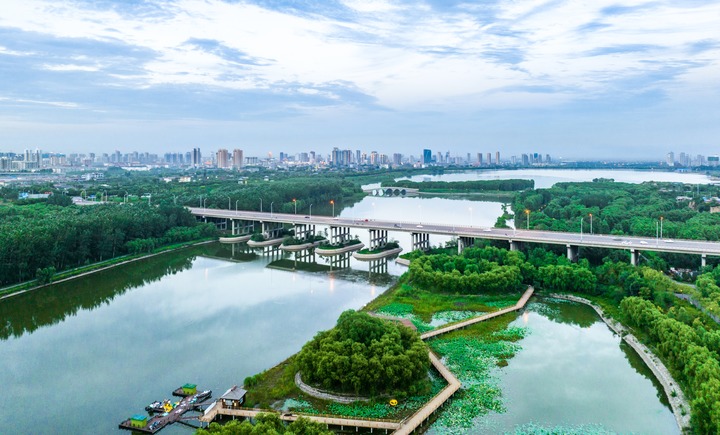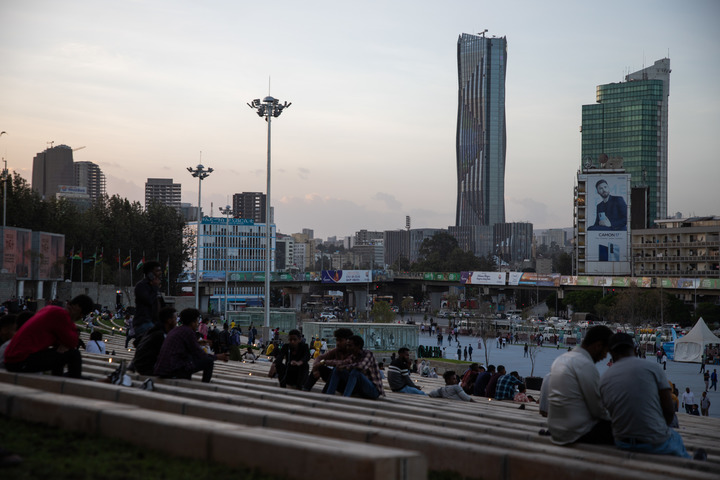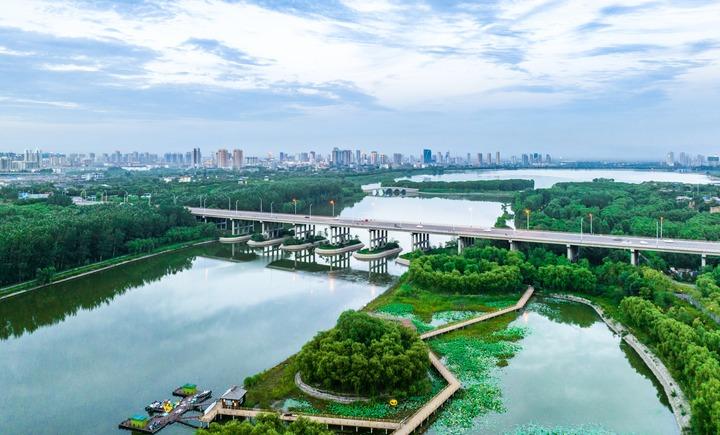BEIJING, Dec. 13 (Xinhua) -- Pledging to peak carbon dioxide emissions by 2030 and achieve carbon neutrality before 2060, or known as "dual carbon" goals, China has been moving forward firmly on the path of pursuing green growth in recent years.
The country's green development achievements have not only boosted the comprehensive green transformation of domestic economic and social development, but also played an active role in leading international cooperation toward sustainable growth.
Through launching green infrastructure projects, making green investment and providing green financing, China has been vigorously practicing the green development philosophy in international economic cooperation with more and more countries, making contributions to reducing global environmental pollution and deepening green economic development worldwide.
-- Walk the green talk
In 2022, China has made remarkable progress towards its "dual carbon" goals with concrete top-down actions, such as unveiling national and local guidelines, pushing forward low-carbon energy transition, upgrading infrastructure in key industries, promoting energy-saving, low-carbon transports and developing the national carbon-trading market.
Over a year since its debut on July 16, 2021, China's national carbon market, the world's largest in terms of the amount of greenhouse gas emissions covered, had seen its total trading volume reach 196 million tonnes, with total transaction volume of 8.58 billion yuan (about 1.23 billion U.S. dollars), according to Li Gao, an official with the country's Ministry of Ecology and Environment.
Li said amid China's green shift, the national carbon trading market had operated in an orderly manner, with structure and rules established and expectations met.
Energy transaction, from traditional fossil fuels to renewable energy, represents a key link in realizing the "dual carbon" goals.
China's installed capacity of renewable energy has sustained growth momentum since the beginning of 2022 amid the country's pursuit of green development. By the end of October, China's total installed power generation capacity reached about 2.5 billion kilowatts, rising 8.3 percent year on year, data from the National Energy Administration (NEA) showed.
The country has planned to build large-scale wind power facilities and photovoltaic bases with installed capacity up to 450 million kilowatts in desert areas, according to the National Development and Reform Commission (NDRC), China’s top economic planner, with the first batch of projects on full steam.
Meanwhile, China has also striven to optimize its industrial structure by developing low-carbon green industries, phasing out outdated capacity and reducing overcapacity.
For example, Shanxi Province in north China, once heavily reliant upon coal resources for economic growth, now is leading the way in the China's low-carbon energy revolution.

Aerial photo taken on July 10, 2022 shows a view of the Xiaohe National Wetland Park in Xiaoyi City, north China's Shanxi Province. (Photo by Wu Jinzhou/Xinhua)
During the 14th Five-Year Plan period (2021-2025), Shanxi will moderately and orderly increase the production capacity of high-quality coal mines while eliminating those suggesting exhausted resources, said Wang Maosheng, deputy director of the provincial energy administration.
The Yungang mine under the Datang International Power Generation Co., Ltd., located in the major coal-producing province, has turned the carbon dioxide from a burden to an asset by refining carbon nanotubes from the exhaust gas of the mines, which could play an irreplaceable role in aerospace, new energy, smart power grids, rail transit, and other industries.
"Technologies of carbon capture and purification provide an economically sustainable path, which allows carbon reduction and economic development go hand in hand," said Song Weining, head of Shanxi's clean carbon-economy industry research institute.
A greener lifestyle is also adopted by many Chinese people, as indicated by the data from the China Association of Automobile Manufacturers (CAAM), which show that from January to September 2022, nearly 4.72 million new energy vehicles (NEVs) were produced and 4.57 million were sold in China.
As a result, the NEV powerhouse has also seen rapid expansion of the charging infrastructure. With over four million charging piles, the country has formed the largest electric vehicle charging network in the world.
"From rapidly growing NEVs to the extensive layout of charging piles, the industry chain of NEVs is full of vitality, injecting 'green energy' into China's economic transformation and upgrading," said Li Baohua, a professor at the Tsinghua Shenzhen International Graduate School.
-- Green efforts reach overseas
Through advocating and practicing green principles in international cooperation, China has been sharing the technology and experience accumulated in its pursuit of green development with various countries, benefiting more people in the greater region.
On the 8th BRICS Environment Ministers Meeting held on May 20, 2022, China's Minister of Ecology and Environment Huang Runqiu said that all sides should join hands in low-carbon technology innovations and provide developing countries and the world with solutions for environmental protection, working closer toward a low-carbon future.
By November 2022, China had signed 45 cooperation documents on climate change with 38 developing countries. By October 2022, the China-initiated international coalition for the Belt and Road green development had gathered more than 150 partners from over 40 countries.
In February 2022, the new headquarters of the Commercial Bank of Ethiopia, built by Chinese construction giant China State Construction Engineering Corporation, was inaugurated. The 209.15-meter-tall landmark building located at the heart of Ethiopia's capital Addis Ababa is equipped with solar lamps outside and self-adjusting light sensors inside, realizing an overall energy saving of 30 percent.

People are seen near the Commercial Bank of Ethiopia Headquarters in Addis Ababa, capital of Ethiopia, Feb. 13, 2022. (Xinhua/Michael Tewelde)
The Ethiopian side of the project praised that the Chinese company had, in a true sense, helped Ethiopia build a modernized building which integrated Chinese wisdom and concepts of green and low-carbon building.
In Kenya, the China-financed Garissa solar power plant has been continuously providing clean energy for local communities and helping facilitate Kenya's quest for green development. It is learned that the plant generates more than 76 million kilowatt-hours of electricity annually, serving hundreds of thousands of people in 70,000 households. The power plant also brings huge green benefits as it saves more than 20,000 tonnes of standard coal each year and reduces carbon dioxide emissions by tens of thousands of tonnes.
With advantages in technology and development scale, China has explored a convenient, efficient and clean development path, which plays a key role in the process of decarbonizing the global energy system, providing a template for other developing countries to learn from, according to Lewis Ndichu, a researcher at Nairobi-based think tank Africa Policy Institute.
In recent years, Chinese solar batteries and electric vehicles manufacturer BYD has been expanding its production lines of renewable energy products in Brazil step by step. It has opened three factories in Campinas of Sao Paulo state and in Manaus of Amazon state, covering business areas including solar power generation, battery storage and NEVs.
The Chinese company has not only brought energy-saving and emission-reduction products and solutions to the Brazilian market, but also created jobs and introduced relevant knowledge and technology to the local communities, according to a Brazilian expert.
China's strenuous effort in developing renewable energy to replace fossil fuels has been a "story of hope" in fighting climate change, said Kevin Conrad, executive director of the Coalition for Rainforest Nations.
-- Greening the Belt and Road
Jointly building the green Silk Road embodies construction of the Belt and Road of higher quality, which means much to combating global climate changes and maintaining the global ecological security.

A giant panda climbs the trunk of a tree at Shenshuping base of China Conservation and Research Center for Giant Pandas in Wolong National Nature Reserve, southwest China's Sichuan Province, April 24, 2022. (Xinhua/Xu Bingjie)
Since June 2016 when China proposed to build a green Silk Road, the country has made active progresses in greening the Belt and Road with enhanced green development philosophy, improved inter-communication mechanisms and deepened pragmatic cooperation.
Being an important participant, contributor and forerunner in global ecological civilization construction, China released a package of related policies centered upon fostering development of green finance and the green finance market to strengthen support to building the green Silk Road.
To date, Chinese financial regulators and the People's Bank of China (PBOC), Chinese central bank, have unveiled the guidance to found the green finance system in China and other policies and documents to leverage the green finance system to further green the Belt and Road.
By the end of September 2022, outstanding Renminbi- and foreign currencies-denominated green loans grew 41.4 percent year on year to 20.9 trillion yuan in China, according to the latest data from the PBOC.
With a large amount of financing pumped into green projects in countries and regions jointly building the Belt and Road, China’s green finance development played a meaningful role in facilitating the green and sustainable development of the Belt and Road.
As the world’s second largest green bond market, China’s green bond market also contributed to greening the Belt and Road with domestic participants financing from the burgeoning domestic green bond market and institutions from the Belt and Road Initiative (BRI) countries and regions and international financial institutions to come to China to issue green panda bonds.
China also actively promoted Belt and Road green finance cooperation to channel more fund into building the green Silk Road.
Since its releasing in November 2018, the Green Investment Principles for the Belt and Road (GIP) has gradually expanded its influence as an international initiative in sustainable finance, with signatories up to 44 ones, supporting institutions rising to 14 ones, and total assets held or under management exceeding 41 trillion U.S. dollars by mid-September 2022.
Green is the color of the Belt and Road. Alongside the increasing demand for green development in BRI countries and regions which generally face challenges from the epidemic, climate changes and loss of biodiversity, green investment and financing standards alignment will further help reduce the cross-border certification costs of green assets and bring new opportunities to their efforts to further green development.
(Edited by Duan Jing, Li Shimeng, Yu Huichen with Xinhua Silk Road, yuhuichen@xinhua.org)




 A single purchase
A single purchase









